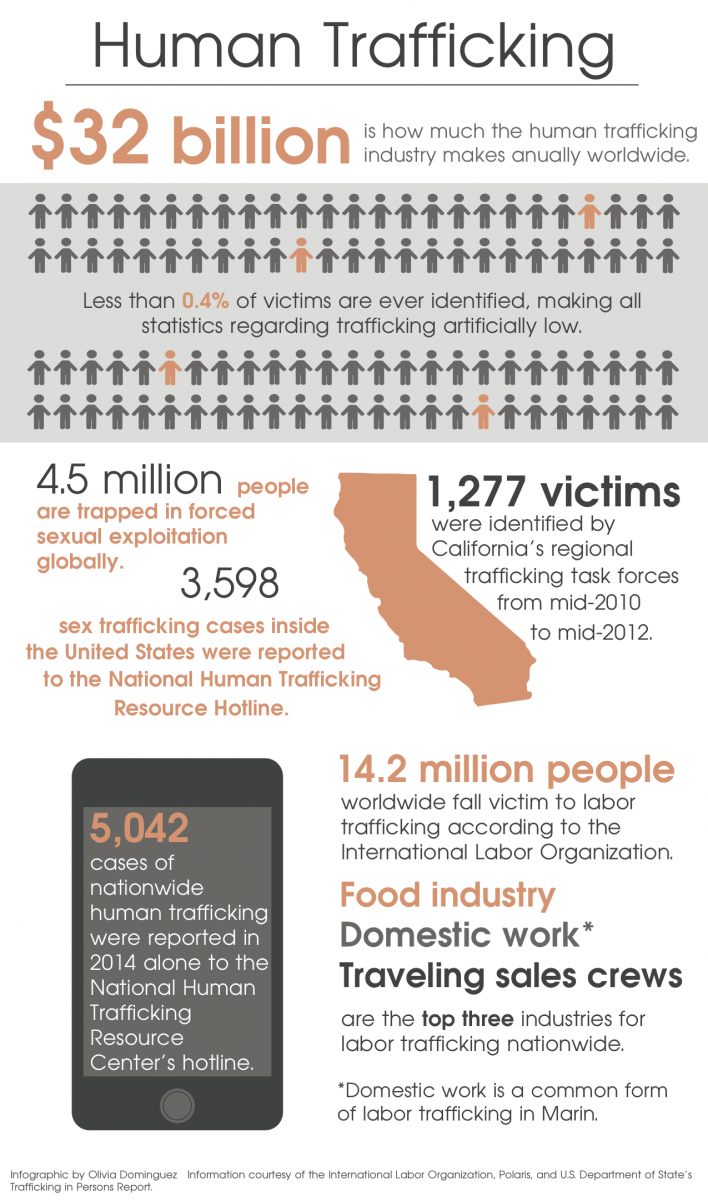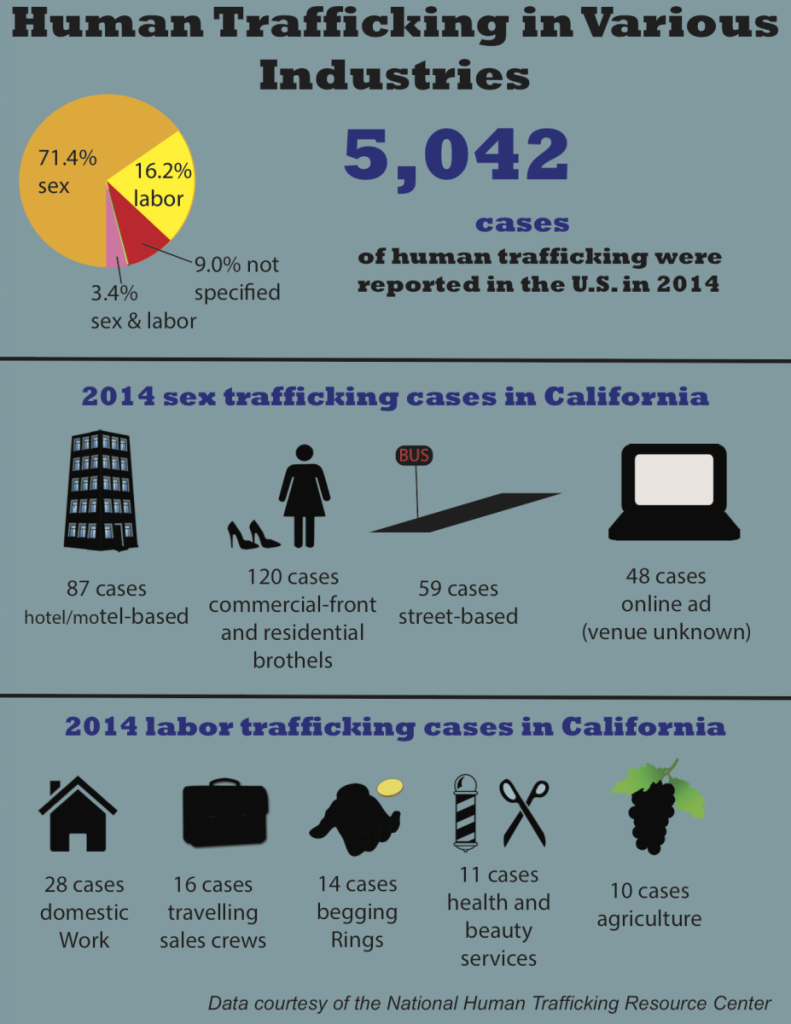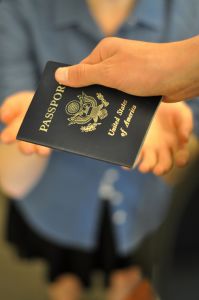
Most of us associate slavery with the world’s bloody past. However, there are more people in some form of slavery today worldwide than at any time in human history, according to BBC News.
Victims of human trafficking, the modern form of slavery, are forced into performing some type of unpaid labor against their will by traffickers who profit off their labor, either in the form of sex work or labor in industries such as the agricultural sector, domestic servitude, and private businesses like restaurants and hotels.
Trafficking does not only occur in impoverished countries, however. According to Marin County Deputy District Attorney Nicole Pantaleo, the San Rafael Canal area is one of the main tracks in the Bay Area for trafficking, and there are also cases in motels along Highway 101.
DeAnna Schlau is the Sexual Assault Response and Volunteer Coordinator at Community Violence Solutions, an organization with multiple service sites throughout the Bay Area that work with victims of trafficking and other forms of sexual abuse. Schlau believes that there is a lack of awareness about trafficking in Marin compared to other counties.
“Marin has had an attitude for a long time that that doesn’t really happen here, and we’re just getting on board with the fact that it really does happen here,” Schlau said.
Despite the misconception that most trafficking victims are brought here from poor countries, 72 percent of victims in California whose countries of origin were identified by the California task forces were native to the United States, according to a 2012 California Attorney General report. Furthermore, Pantaleo said that about half of the victims with whom she works are from Marin County.
“I think we have a tendency to want to hide our dirty laundry at the margins of our consciousness,” said Brian Wo, Co-Founder of the Bay Area Anti-Trafficking Coalition. “We don’t want to believe that not only is it happening here, but it’s happening to people from here—it makes it more uncomfortable for us.”
Emily Sims was a victim of sex trafficking in Marin. She is the founder of West Marin Advocacy, a social service agency for survivors of family and community violence.
Sims, a West Marin native who attended White Hill Middle School and then Branson for a year, was sexually exploited for three years of her life, beginning in her second year of college at Golden Gate University in San Francisco in 1991. When she met her exploiter, he acted as if he wanted a romantic relationship with her, and listened to her when she opened up to him about her bisexuality.
“I had just gone through a breakup, so I felt very heart broken,” Sims said. “My exploiter came along—I met him in public actually, walking down the street in San Anselmo. He seemed handsome and kind. About a couple of weeks into the relationship, he sexually assaulted me. I was really scared about who to tell. There weren’t a lot of public awareness campaigns about resources for sexual assault survivors, and I was ashamed to tell my family.”
Sims was also sexually assaulted by other people besides her trafficker.
“He had a lot of friends and associates [with whom] he basically traded me around for sex, and he benefitted from that personally and professionally,” she said.
A Visible Issue
In 2014, West Marin Advocacy alone worked with 30 survivors of sex or labor trafficking, some of whom were native to Marin, and others who were trafficked into the county from other places. One third of these victims were younger than 18. Some of the youth survivors Sims has worked with have been high school students from Tam and Novato.

However, despite the existence of trafficking in Marin, the county is still in the process of developing a protocol for human trafficking cases, according to Sergeant Scott Eberle of the San Rafael Police Department’s Street Crimes Unit.
According to Schlau, before the county started recognizing trafficking cases in 2014, almost all sex trafficking victims were arrested for prostitution because law enforcement did not distinguish trafficking from prostitution.
“Even if they’re in it completely unwillingly, they’re getting a juvenile or adult record for this and it makes it difficult for them to have a legitimate job later,” Schlau said. “It further entraps them in that life because they feel like they’re looked at as a prostitute. They can’t just go work at Starbucks.”
In the past 10 years, San Rafael has had more than 1,200 prostitution-related cases, while in 2014, it had only five human trafficking cases.
Schlau believes that sex trafficking exists in Marin because of demand.
“There [are] a lot of people purchasing sex and have the money to do so,” she said. “Exploiters know that and bring the victims to Marin for business.”
Human trafficking, however, has only been recognized by lawmakers in the state since 2006, with the passage of the California Trafficking Victims Protection Act, which established trafficking as a felony and created the California Alliance to Combat Trafficking and Slavery, a statewide task force. Nationwide, the Trafficking Victims Protection Act of 2000 was the first legislation to declare human trafficking as a crime.
In the Bay Area as a whole, trafficking is an extremely visible issue. The FBI cited San Francisco as one of its 13 highest child sex trafficking regions in the country, along with Los Angeles and San Diego.
According to the Attorney General Report, California is one of the top four locations in the United States for trafficking. Sims said that the presence of slavery in California throughout its history is what makes human trafficking so prevalent in the state nowadays.
“It was legal to enslave Native American adults and children for labor and sexual trafficking, and during the gold rush African American slaves from the East Coast were brought to California,” Sims said. “So slavery as a concept in of itself is something that has existed in California since statehood began.”
Psychological Manipulation
While Schlau said that some traffickers, called “guerilla pimps,” kidnap girls on the street who look vulnerable, far more common are “Romeo pimps,” who pretend to romance victims before taking advantage of them.
Sims explained that her trafficker used psychological manipulation to force her into compliance, instilling feelings of isolation and fear in her mind.
“I shared with him the experiences that I had around homophobia, and that’s something he ended up using against me,” Sims said. “When I wanted to leave him, he threatened to out me to my friends and my family, and I was terrified.”
Traffickers also try to lower victims’ self-esteem, according to Schlau.
“Part of what the perpetrators do to break them down emotionally is [say], ‘You’re nothing, nobody wants you, nobody respects you, you’re not worth anything,’” Schlau said. “If you hear that enough, you start to believe it.”
Schlau also said that often, the public does not understand that traffickers use manipulation to keep victims compliant.
“One of the attitudes that is a big problem is that people think, ‘Well, if that happened to me, I would want to get out of the life, I would be trying to get away,’ and it’s the same thing with any sexual assault. People think, ‘Well, didn’t you fight him off? Didn’t you try and run away?’” Schlau said. “There’s so much coercion and so much fear involved that people aren’t running down the streets screaming, ‘Help me! when [trafficking] happens. They’re afraid and they don’t know what their options are, and they feel trapped.”
Who is at risk?
Eberle said that the majority of the sex trafficking victims he has worked were either minors or slightly older than 18. Those at risk for trafficking often include youth from impoverished and broken homes and runaways.
“These guys prey upon [victims], and [are] pretty much the first people in their lives who actually pay attention to them, make them feel good,” Eberle said. “You’d be amazed how far saying, ‘You’re beautiful, you’re beautiful’ [goes].”
According to Schlau, children who were sexually abused early in life also have a higher risk of being trafficked.

“Having those kinds of boundaries crossed when they were a kid about their safety and their sexuality, and having that kind of confusion around it when they were a kid, sets them up for not knowing what’s safe and what’s not later on,” Schlau said. “If you’ve had unsafe people around you when you’re growing up, you don’t necessarily know what safe people would be like, or how to recognize it.”
Additionally, many of the survivors Sims has counselled in Marin fell victim to bullying in high school.
“One of the risk factors [is] girls who are just bullied at school, girls bullied for not having trendy clothes, or having enough money, girls who are bullied for being black or mixed race,” Sims said.
Though Schlau acknowledged that poverty is a driving factor in trafficking, she said that youth of all socioeconomic levels can fall victim, particularly children who have felt neglected.
“Technically [a victim] has what she needs in life, but she doesn’t feel like she has love or guidance,” Schlau said. “Being pulled in by somebody who’s romancing her in that way might be the vulnerability that she has.”
It is not just women and girls who fall victim to both sex and labor trafficking. According to a 2014 report compiled by the United Nations Office on Drugs and Crime (UNODC), 30 percent of human trafficking victims are men and boys.
Wo said that one of the shortcomings of anti-trafficking efforts is the lack of shelters and resources for men and boys who are trafficked.
“For men, it’s more the labor trafficking side, but there are boys who are getting sex trafficked, and that’s still a pretty underground industry. That’s a growing industry,” Wo said. “I think more and more boys are going to be rescued, and we will be needing services for them. They have unique needs that women or girls don’t have.”
Labor Trafficking
Although sex trafficking gets more media coverage than any other type of trafficking, only 56 percent of the victims of human trafficking identified by California’s regional trafficking task forces were victims of sex trafficking.
Labor trafficking is also very prevalent, which involves the exploitation of a victim for economic activities, and it is more prevalent on a global scale, with 14.2 million people worldwide falling victim, according to the International Labor Organization (ILO).
Throughout the Bay Area, labor trafficking occurs in a variety of industries including in restaurants, hotels, agriculture, construction work, and even street vendors. According to the Washington D.C. based nonprofit Polaris, the top three industries nationwide for labor trafficking are domestic work, travelling sales crews, and restaurants/food service.
Sims said that domestic work is a common form of labor trafficking in Marin. Victims of this type of labor trafficking are held against their will and forced to do work in private homes as maids, nannies, or gardeners.
Victims of all forms of labor trafficking are often enticed by online postings advertising an economic opportunity in America, Schlau said.
“[The ads are] always very flowery, ‘Oh come here and you’ll work and make a living, you can send money home, or you’re coming to the American dream,’ all of that, and then it turns out to be something completely different,” Schlau said.
Schlau said that it is incredibly difficult for victims of labor trafficking to escape their predicament.

“They’re completely dependent on the exploiter,” she said. “They don’t know their way around, they may not know the language, whatever papers like a visa or passport or whatever they may have had for identification are being held by the exploiter, so they don’t feel like they have any way to go out in the world and get some help.”
According to Eberle, it is a challenge for law enforcement to identify cases of labor trafficking because victims, who are often undocumented, are usually afraid to come forward.
However, victims of human trafficking who are undocumented will not be deported if they obtain what is called U nonimmigrant status, or a U visa, which is valid for four years. To obtain this legal status, the victim must testify and assist law enforcement in prosecuting the case against their trafficker, which Eberle said can be scary for victims, as traffickers often make threats against victims and their families.
“There’s still no guarantee that your family is safe back in your home country because we can’t go back to whatever country you’re from and protect your family,” Eberle said.
Schlau has worked with victims of labor trafficking, and mentioned one case in particular where a victim came from Western Europe to work what seemed like a legitimate job in a hotel. Upon arrival, however, the victim’s passport and documentation was withheld by their trafficker, and the victim was forced to work nearly 24 hours a day for no or incredibly little pay.
“You may walk in to rent the hotel room and [the victim] may be doing the interaction like normal, but really they feel like they don’t have a choice to be there, and they don’t trust that they can just go, ‘Hey, help me’ because you might not be able to help them,” Schlau said. “And then they’d be in trouble with the exploiter, who could make their life even more miserable.”
Challenges for Law Enforcement
Eberle said that the San Rafael Police Department is successful at identifying trafficking cases, using a variety of surveillance techniques including monitoring online escort sites, as well as responding to calls and conducting patrols.
However, actually catching traffickers poses many challenges for law enforcement, particularly when it comes to interaction with victims.
Eberle said that due to the psychological manipulation that victims experience, most of the time victims do not fully understand their predicament
“Almost 100 percent of the time, they are always going to say that they are independent, they’re not victims, they’re doing this out of their own free will,” Eberle said. “So then you really have to get down to the human element of this crime, and understand that these girls have been brainwashed, manipulated into thinking that what they’re doing is helping out some guy. She feels that she’s not really doing anything wrong at all.”
Law enforcement looks for certain signs when they are questioning victims.

“There are signs too that we look for: black eyes, bruises covered up, not looking at us,” Eberle said. “The telltale one always is when we bring it up, they’ll say no but their eyes will start to water.”
According to Eberle, another major challenge in prosecuting trafficking cases is getting victims to testify against their traffickers.
“Once you even get past that hump of convincing the victim that we are there to help them out, it’s scary to testify in court, to give a statement, to know that you are ‘snitching’ on someone who has a gun,” Eberle said.
However, Eberle added that one of the biggest challenges in combating trafficking is changing the way police officers view victims.
“The challenge that we have to deal with as a society is [changing] police officers’ values and [making] them believe that these girls are not out there on their own, they are being forced into these things, and nobody needs to be holding a gun to their head to show that this coercion exists,” Eberle said.
That being said law enforcement has made significant progress in combating the issue, according to Eberle. Police Officer’s Standards in Training (POST), which regulates all guidelines for police officers’ training in California, began mandating last year that officer’s watch a two hour video on trafficking.
Although Sims managed to make enough of a living to support herself and escape her trafficker, she said that some victims aren’t as fortunate and are too afraid to report their situation to law enforcement.
“I know how terrifying it can be for people to come forward if someone is being sexually assaulted or experiencing violence in their own relationships,” Sims said. “Sometimes they face a lot of backlash in coming forward and I want to try and let people know that they’re not alone in that.”
To call in a trafficking tip, call the National Human Trafficking Resource Center Hotline at 1-888-373-7888 or text HELP to BeFree (233733)











